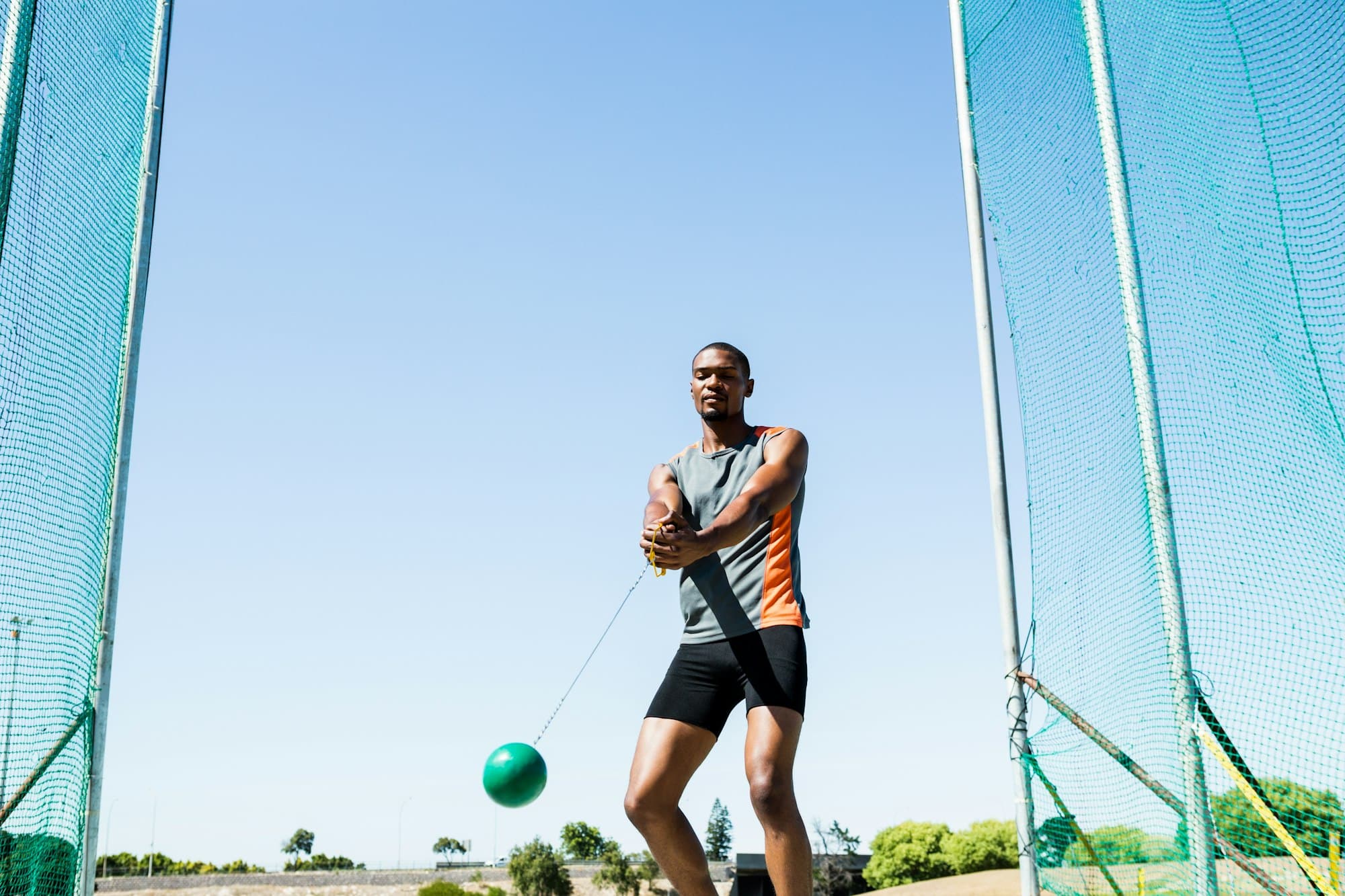What’s the Best Technique for Maximizing Kinetic Energy in Hammer Throwers?

You may perceive the hammer throw as a straightforward sport, where the athlete simply whirls a heavy object around their head before releasing it. However, a closer analysis reveals a complex interplay of timing, rotation, and energy transfer. This article will delve into the fundamentals of hammer throw technique with a primary focus on maximizing kinetic energy. This is a crucial aspect as the amount of energy transferred into the hammer dictates the distance of the throw.
The Role of the Upper Body in the Hammer Throw
In the hammer throw, the upper body plays a significant role in generating the energy necessary to produce a successful throw. Key areas to focus on include the shoulder rotation and the torque produced in the throwing phase.
A lire également : What’s the Effect of Multi-Sensory Training on Reaction Times in Sprinters?
Analyzing the shoulder rotation during the hammer throw, one study published in PubMed highlighted the impact of the shoulder’s angular velocity during the throw. A quicker rotation of the shoulders allows more energy to be transferred to the hammer, which ultimately increases the distance of the throw.
The concept of torque also factors into the throwing phase. The upper body should act as a lever, generating force that is transferred to the hammer. The faster the athlete rotates their upper body, the more force they produce. This is why hammer throwers are often seen spinning rapidly before releasing their throw.
A voir aussi : What’s the Impact of Leadership Skills Training on Team Dynamics in Youth Soccer Coaches?
The Importance of Leg Strength and Foot Placement
The legs, specifically the velocity at which they can move, is an integral component to a successful hammer throw. The force generated in the legs during the rotational phase contributes significantly to the overall energy transferred to the hammer.
The foot plays a crucial role as it provides the necessary grip and balance during the rotational phase. A solid foot placement, coupled with a quick rotation, can boost the angular momentum, leading to a more powerful throw. It’s worth noting that the foot also acts as the pivot point during the throw, allowing the thrower to maintain their balance while rotating at high velocities.
The Role of Timing in the Hammer Throw
Timing is a critical component in the hammer throw. The synchronization of upper and lower body movements, particularly during the rotational and throwing phase, can significantly increase the force applied to the hammer, and thus, the throw distance.
A PubMed study suggests that the optimal timing for releasing the hammer is at the peak of its upward swing. This results in the maximal transfer of energy from the body to the hammer, leading to a longer throw. Thus, mastering the timing of the throw is essential for maximizing performance in this sport.
The Energy Transfer in a Hammer Throw
The hammer throw is an excellent demonstration of energy transfer. The athlete’s body generates kinetic energy, which is then transferred to the hammer, propelling it into the air. Understanding this energy transfer process is essential for improving performance.
Studies have shown that the hammer thrower’s rotational velocity and the torque produced by their body play vital roles in the energy transfer process. The faster the athlete rotates, and the more torque they generate, the more kinetic energy is transferred to the hammer. Thus, training programs should focus on improving these two aspects to maximize energy transfer and, hence, throw distance.
Using Biomechanical Analysis to Improve Performance
Biomechanical analysis is increasingly being used to enhance performance in sports. By analyzing an athlete’s movements, coaches can identify areas of improvement and recommend effective training methods.
In the context of the hammer throw, biomechanical analysis can provide insights into the thrower’s rotation velocity, shoulder rotation, leg strength, and timing. These insights can then be used to design personalized training programs aimed at improving these aspects, thereby maximizing kinetic energy transfer and improving throw distance.
In conclusion, the technique for maximizing kinetic energy in hammer throwers revolves around several factors such as the upper body rotation, leg strength and foot placement, timing, energy transfer, and biomechanical analysis. By understanding and improving these aspects, hammer throwers can increase their throw distance and enhance their performance.
Ground Reaction Forces and Its Role in Hammer Throw
Ground reaction forces play a crucial part in the hammer throw. As Newton’s Third Law states, "For every action, there’s an equal and opposite reaction," this principle applies in the hammer throw. When athletes apply force into the ground via their foot placement, the ground returns an equal force, leading to the creation of potential energy.
The ground reaction force in the hammer throw is the result of the thrower’s foot pushing down against the surface during the rotation. The surface, in turn, pushes back with an equal and opposite force, propelling the athlete and the hammer upwards. This action-reaction interplay forms the basis of the "kinetic chain" – where energy from one movement feeds into the next one, creating a chain reaction of energy transfer.
The ground reaction force is also tied closely with the athlete’s center of gravity. To maximize this force, athletes need to maintain a low center of gravity during the rotational phase while ensuring a high center of gravity during the delivery phase. This shift in the center of gravity, coupled with the ground reaction force, contributes significantly to the angular momentum of the throw.
Sport med professionals often highlight the influence of ground reaction forces on the throwing arm as well. During the delivery phase, the hammer thrower’s front leg acts as a brake, causing the throwing arm to whip forward, releasing the hammer with maximum velocity.
The Interplay of Body Mass and Energy Transfer
In the world of track and field, the mass of the athlete is another crucial factor to consider in the hammer throw. The principle of the conservation of angular momentum states that an object’s total angular momentum remains constant unless acted on by an external torque. In simpler terms, the greater the thrower’s mass, the more kinetic energy they can generate and transfer to the hammer.
The athlete’s center of mass also comes into play here. When the athlete rotates, they create a torque around their center of mass. This rotational technique helps in transferring the potential energy generated in the athlete’s body into kinetic energy within the hammer.
It’s also critical to note that the hammer thrower’s body mass should be distributed evenly. An uneven distribution can lead to instability during the rotation, reducing the angular velocity and, consequently, the kinetic energy transferred to the hammer.
This principle also emphasizes the importance of the thrower’s power position. Positioning the body to ensure the center of mass remains stable throughout the throw can significantly enhance the energy transfer and thus the throw distance.
Conclusion
Maximizing kinetic energy in hammer throwers is a complex process involving various factors, from shoulder rotation and leg strength to timings and ground reactions. The athlete’s body mass and its distribution, along with their ability to generate and transfer energy, play crucial roles in determining the success of the throw. Biomechanical analysis and the principles of physics provide invaluable insights into this intricate process.
Understanding these inputs helps in designing personalized training programs for throwing athletes, aimed at enhancing their performance. By focusing on these aspects, athletes can maximize their potential, turning the simple act of throwing a hammer into a remarkable display of power, speed, and precision.
Ultimately, the hammer throw is not just about strength – it’s about the right combination of technique, timing, and understanding of the biomechanical aspects involved. The athlete who masters these components will indeed stand out in the field, demonstrating that the hammer throw is a true blend of science and sport.
